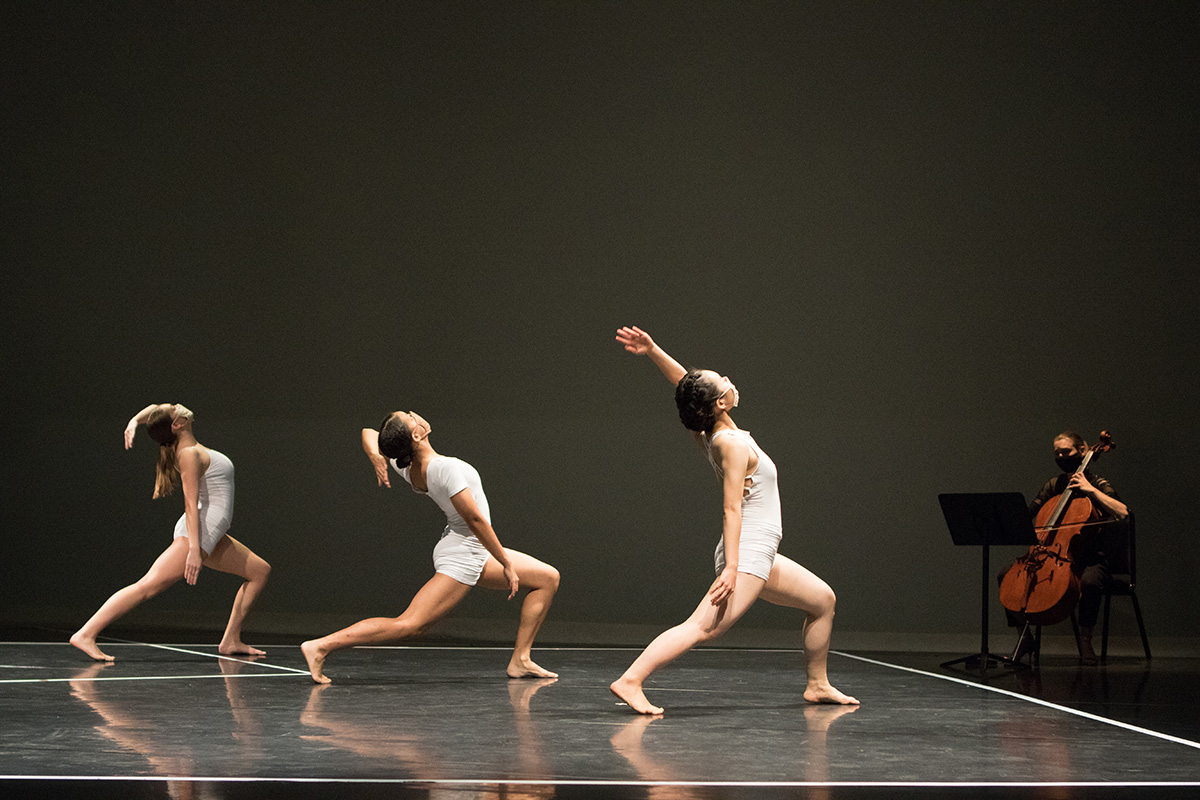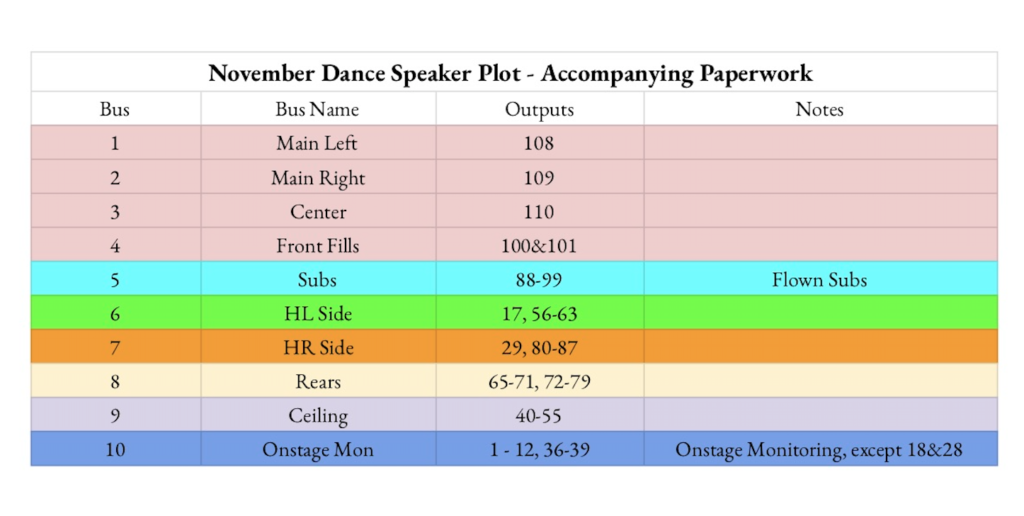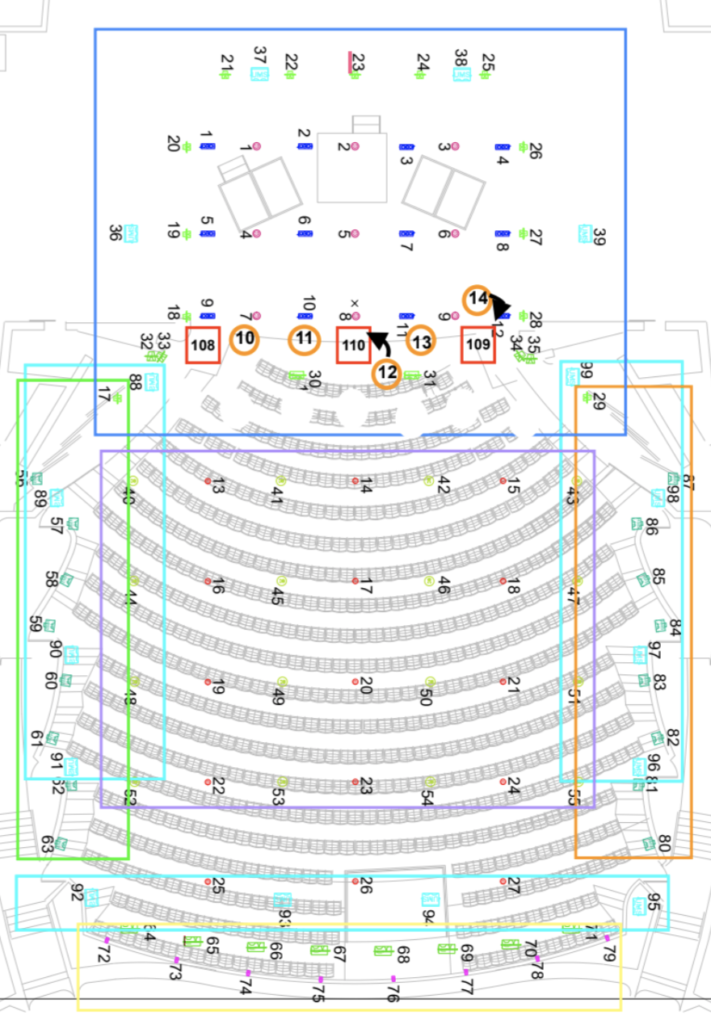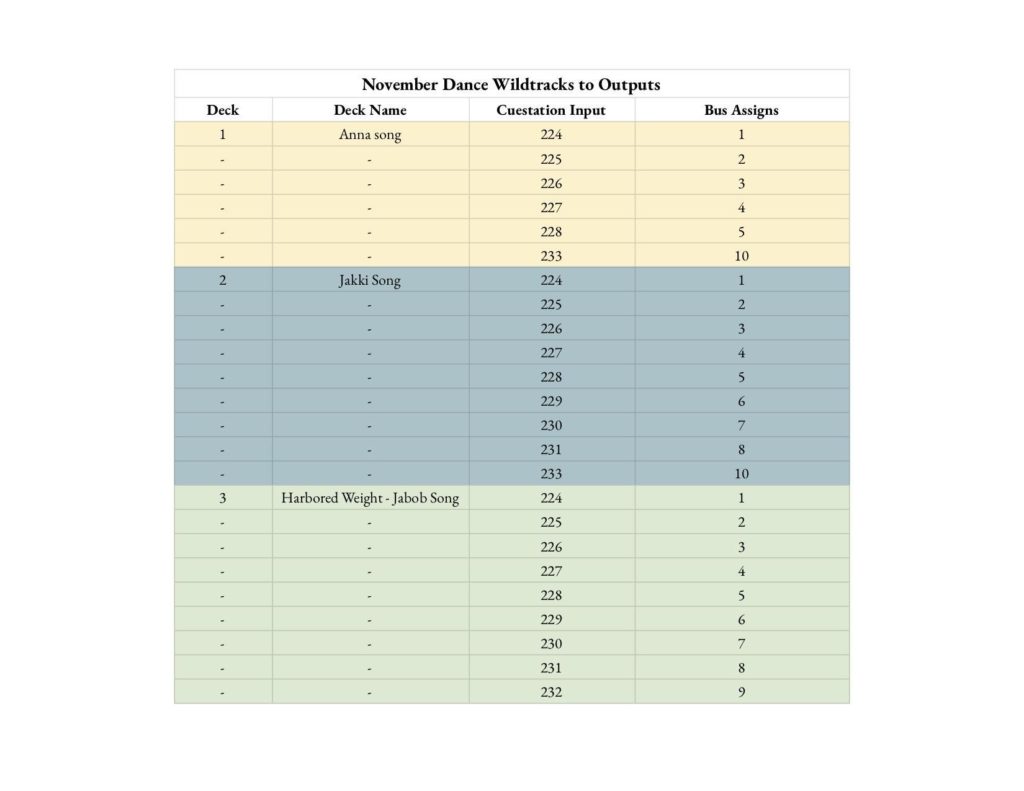Using an array of ambient sensing microphones, digital signal processing, and world-class speakers, Constellation modifies the reverberant characteristics of a venue and redistributes sound throughout the space – ensuring a natural acoustic experience. I am very fortunate to have had the experience to design with this system. The Krannert Center for the Performing Arts recently had one of these systems installed into their Colwell Playhouse Theatre. In this article, I will go over how I designed this system for the 2021 November Dance show, how I utilized the 100+ speakers, and how I shaped the environment of each dance piece.
I began the design process by grouping my outputs into zones where they could fulfill a certain purpose. In Cuestation; Meyer’s software interface for their D-Mitri systems; these groups are called buses. I utilized a total of ten buses and over 80 speakers out of the original 127. Paper working and making sure things were clear for my engineer was a new challenge. This system is large and I found color coding and adding legends with further notes really helped represent the system I needed, but also the system that would become the world for the show, audience, and art that dancers were bringing into the space.
These zones allowed me to create a truly immersive experience with the sound. I was consistently using the House Left and Right sides, Rears, and Ceiling buses. However, what I loved the most was the Sub bus. Rather than using the onstage subs with the arrays, I opted to use the installed flown subs. What I have experienced in previous designs is that I prefer the encompassing blanket of sound that subs give when they are flown from a distance. I really didn’t want to localize them to the stage. I did, however, use the Center and Front Fills buses to draw more attention to the stage and dancers. I found that I preferred this balance of sound and the image that is created as an audience member.
I also found that the color-coding, legends, and graphics really helped keep track of this system. It felt daunting at first, but this breakdown allowed me to easily manage all of my outputs. The dance productions here don’t get a ton of time for the tech process, so this setup really helped me adjust levels quickly and not get bogged. I hadn’t worked with this software for a show before and it comes with a learning curve. I needed to stay productive throughout the entire rehearsal process.
Playback also works differently in Meyer’s Cuestation. Playback is often triggered and played back in Wildtracks. Wildtracks uses decks – virtual decks that is. It felt reminiscent of my Dad’s tape deck when growing up. Even though the tech process for this production added several more decks and cues to my original paperwork, I will show you the initial documents and how I set up my playback.
Originally each dance piece had its own deck. You can also see that each dance had a varying amount of Cuestation Inputs. These are the Wildtrack inputs that I then assigned to my buses of speaker zones. For Anna and Jakki’s pieces, I received stereo files. Though this was less than ideal, I stilled sent the music to the buses and crafted a great sound for the piece. Subsequently, I was the designer for Harbored Weight, so I had more opportunities to work with stems and individual tracks to send and pan around the room.
This is the kind of world I like to think and live in as a designer. There was a fourth dance that used only live music. This one was titled Love and only had a Cellist mic’ed on stage. Harbored Weight also had a live pianist accompanying the dancers. With Cuestation, I was able to take the mic’ed signal from these instruments and also send them to my buses. I could do this for onstage monitoring for the dancers or artistically in the house. What I discovered though, was that I could achieve a beautiful presence in the house with the other half of this design – which involves Constellation.
I sculpted a unique constellation setting for each dance piece. This information would be saved within each Cuestation cue – thus being recalled for the top of each dance by the stage manager. Most of the choreographers really wanted a large-sounding reverb. One, in particular, asked for something as close to cave-like as possible. I love these kinds of design requests.
Not only was I able to start with a base setting like ‘large hall’, but I was also able to effect parameters like early reflections, which really helped create a huge immersive sounding space. I was up against a learning curve though. I realized that with the constellation cue, audience members would be applauding at the end of the dance and their claps would be accentuated and echoed around the theatre. I found this to be cool sounding, but obnoxious. This resulted in me having to program more cues and use more Wildtracks decks to turn off Constellation for the end of each dance.
Then there are the designated microphones that capture the sound that makes Constellation processing what it is. For Donald Byrd’s piece Love, I was able to put this already beautiful cello sound through the processing system and hug the audience with its sound and warmth. This really helped for a few reasons. The dance was set to several Benjamin Britten pieces and it was just the cellist and dancers on stage. One cellist can sound small in a large theatre and the choreographer really wanted a big full sound. I mic’d the cello with a DPA 4099, but also used the ambient microphones to capture the instrument and send the signal through the constellation processing and unique patch that I had created. I designed a really warm and enveloping sound that was still localized to the stage and gave the illusion of a full orchestra.
My design for the 2021 November Dance did not incorporate Meyer’s Spacemap side of Constellation. I was able to do everything artistically that I wanted and that the choreographers needed without using Spacemap. I do look forward to using it in future designs though. If this article intrigues you, I would highly recommend looking into Spacemap as well as Spacemap GO.
I love that I can find ways to be a designer and be artistic outside of the typical realm of what it means to be a sound designer. I challenge the idea that crafting a sound system that shapes the sound we play through it isn’t artistic. I think this article shows that this way of thinking is in fact art. Dance often defaults to left-right mains with onstage monitors and side fills, but contemporary dance is pushing against that envelope. Sound designers and other artistic minds need to be there to receive those pushbacks and birth a new way of making art. Much like how Meyer continues to develop innovative tools that help us be better artists and better storytellers.
Photo credit goes to Natalie Foil. All other images within this article are from my personal paperwork for the 2021 November Dance production.



